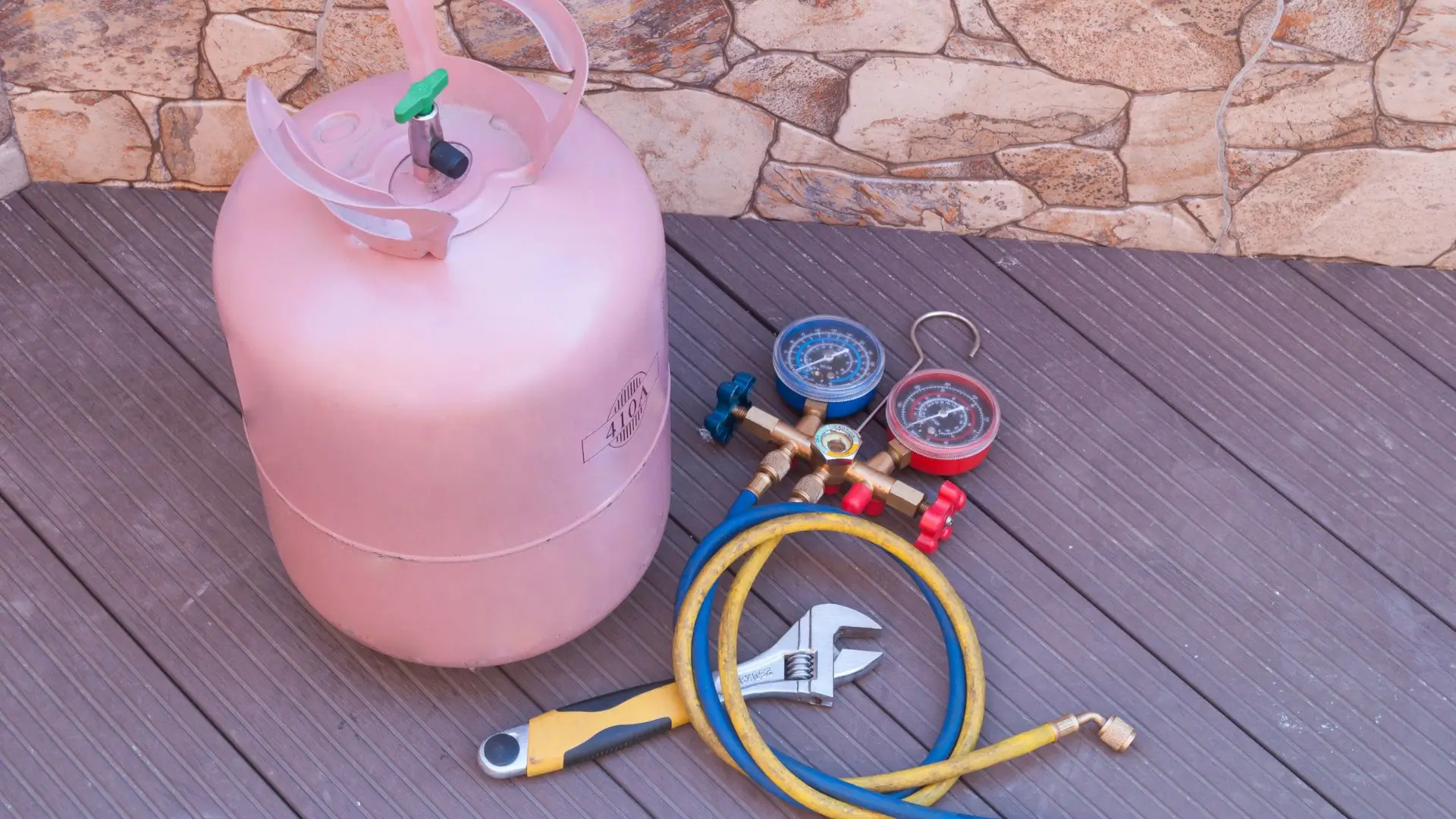Is your home’s cooling performance steadily declining despite an air conditioning system that seemed to work fine just last summer? Are you noticing questionable moisture issues, unusual operational noises, or spiking energy costs despite no major setting changes? If so, you could be dealing with a refrigerant leak.
This precious coolant that circulates through your AC system enabling its all-important heat transfer cycle doesn’t last forever. Over months and years of operation, tiny cracks or loose connections can develop along refrigerant lines and component fittings. Those subtle escape paths slowly but steadily allow the system’s charge levels to become depleted.
Left unaddressed, dwindling refrigerant reserves translate directly into degraded cooling performance as there’s simply less fuel facilitating the thermal transfer process. But cooling shortfalls represent just one potential symptom of a leak. This guide covers other common red flags indicating your system is losing its cool due to refrigerant issues – from frozen coils and moisture problems to spiking utility costs.
You’ll learn why maintaining optimal refrigerant levels remains so critical, explore the various potential leak causes, and discover the risks of letting these leaks persist long-term. We’ll also provide tried-and-true preventative maintenance tips to maximize your system’s refrigerant charge longevity. Don’t let a sneaky leak compromise your comfort!

What is Refrigerant and Why is it Important?
Before we dive into the telltale signs that your AC is springing a refrigerant leak, it’s important to understand exactly what this substance is and why it plays such a vital role in your cooling system’s operation.
Essentially, refrigerant acts as the heat transfer “fuel” that makes the entire air conditioning cycle possible. This specialized chemical compound circulates between your system’s indoor and outdoor units, continually alternating between liquid and gaseous states through compression and expansion.
As refrigerant passes through the indoor evaporator coil in a liquid state, it absorbs thermal energy from household air – cooling and dehumidifying it in the process while transitioning into a vapor. That hot gaseous refrigerant then travels outdoors where it expels the absorbed heat into the surrounding air as it condenses back into liquid form. This continual phase-changing cycle is what enables the refrigerant to remove thermal energy from inside your home.
For this heat transfer process to function at peak efficiency, an AC system requires a precisely measured “charge” or amount of refrigerant based on its specific size and design specs. Not enough refrigerant and there’s insufficient cooling fuel to facilitate effective heat removal. Too much and liquid can flood back into areas reserved for vapor compression only.
That’s what makes maintaining optimal refrigerant levels so critical. Any leaks depleting charge amounts directly translate into your system’s diminishing ability to do its cooling job consistently. Shortages don’t just hamper indoor comfort but also accelerate wear on components straining to compensate for the performance deficit.
From facilitating the entire thermal transfer cycle to maximizing cooling output and equipment longevity, refrigerant represents the beating heart keeping your air conditioner operating reliably through each sweltering summer season. Any signs of potential leaks demand a prompt investigation to protect that investment.
Common Signs of a Refrigerant Leak
While refrigerant leaks can initially develop incredibly slowly and small, that steady coolant depletion inevitably manifests itself through a variety of performance issues. From reduced cooling output and moisture problems to spiking energy consumption, several common symptoms frequently reveal when your AC isn’t operating with an optimal refrigerant charge.
Reduced Cooling Efficiency
As refrigerant levels drop due to a leak, so does your system’s ability to effectively remove heat and humidity from your home’s air. You might notice warm spots or uneven temperatures from room to room. Or interior spaces simply feel muggier and take longer to cool down overall despite the AC constantly running. Refrigerant shortages directly compromise an air conditioner’s cooling transfer performance.
Hissing or Bubbling Sounds
Whenever an AC system cycles on, listen closely for any abnormal hissing or bubbling noises around the indoor air handler unit or outdoor condenser. Those sounds can indicate refrigerant escaping at connection points throughout the line set tubing linking components together. Compressors frequently emit louder noises too as they struggle against lower coolant levels.
Frozen Evaporator Coils
It seems counterintuitive, but refrigerant shortages commonly cause indoor evaporator coils to freeze over and accumulate ice. As coolant reserves dwindle, inconsistent refrigerant flows allow cold spots to develop where condensation freezes. Beyond hindering airflow, this frost accumulation also prevents effective dehumidification from occurring.
Increased Energy Bills
Have your monthly electricity costs been inexplicably climbing recently despite no real change in cooling usage habits? Rising utility expenses can absolutely indicate an AC system laboring harder to compensate for depleted refrigerant levels. With less efficient heat transfer occurring, components tax energy reserves working overtime to achieve the same cooling output.
Warm Air from Vents
A total absence of cool airflow from your vents likely signals an advanced refrigerant shortage emergency. Once reserves become critically low, an AC system simply lacks the thermal transfer fuel required to produce any chilled air whatsoever. At most, you’ll feel ambient temperatures blowing from supply registers despite the system running.
Visible Refrigerant Leaks
While not always easy to pinpoint, sometimes refrigerant leaks make themselves blatantly known leaving oily residues or moisture around fittings, coils, or the compressor itself. If you notice any signs of liquid pooling or corrosion forming on copper line set tubing, chances are high you’ve got an active leak depositing those dead giveaways.
From reduced cooling capabilities and moisture problems to clearly compromised condenser operation, a variety of symptoms frequently indicate when your air conditioning system’s refrigerant reserves need replenishing. The key lies in recognizing those red flags before minor leaks spiral into major component breakdowns putting your comfort at prolonged risk.
Causes of Refrigerant Leaks
Now that you’re well-versed in the various ways a depleting refrigerant charge might make itself known, let’s examine some of the most common underlying reasons those leaks frequently develop in the first place. From environmental factors and age to installation missteps, several typical culprits tend to contribute to AC systems springing those costly coolant seepages over time.
Wear and Tear
As air conditioning equipment ages through years of near-constant seasonal operation, its numerous refrigerant line connections and fittings simply start wearing down. Rubber gaskets and seals harden, thermal contraction causes metal joints to loosen, and vibrations work components loose bit-by-bit with every cooling cycle. All that deterioration gradually opens up microscopic escape paths where refrigerant can slowly seep out.
Corrosion
Another insidious threat facilitating leaks stems from the various forms of corrosion waging war on exposed metal surfaces and joints throughout an AC system’s line set tubing. Chemical reactions between copper piping and atmospheric conditions like moisture, salt air, and acid rainfall steadily eat away at refrigerant pathways until pinholes and cracks develop. Corrosion inhibitors can only forestall this inevitability for so long.
Poor Installation
While ideally the exception rather than the rule, shoddy air conditioner installation workmanship from unqualified contractors or shady services represents another common refrigerant leak backstory. Improperly purged or evacuated systems leave contaminants that rapidly degrade connections. Kinked line sets restrict flow. Over/under torqued fittings eventually fail. Cutting corners during set-up guarantees a slow but steady coolant seepage timeline.
Physical Damage
Finally, there’s also the element of accidental abuse and site hazards that AC systems endure which can enable refrigerant escape routes to open up. Landscaping equipment crashing into line set tubing, rodents chewing on accessible components, storm debris impacts…the potential for cuts, dents, and other damage enabling leaks runs rampant in the great outdoors where condensers reside.
From the unpreventable factors of age and environmental exposure to the human elements of workmanship or sheer circumstance, all air conditioning systems, unfortunately, face a wide range of leak risk contributors as they log more operational hours. Keeping an eye out for telltale symptoms provides the key to catching developing issues before depletion creates more extensive cooling emergencies.
Potential Risks and Consequences
While that slowly dwindling refrigerant charge thanks to a leak might seem like more of a nuisance issue at first, neglecting the problem can quickly open the door to far more severe consequences. From spiking utility costs and accelerated system wear to genuine health hazards, ignoring clear signs of refrigerant depletion proves unwise for several reasons.
Diminished Cooling Performance
The most obvious risk stemming from unchecked refrigerant leaks involves your home’s overall air conditioning performance becoming severely compromised. As charge levels drop lower and lower, your system loses its ability to effectively remove heat and moisture from interior spaces. Warm spots, muggy air, and general discomfort become the new normal despite the AC running constantly.
Compressor Burnout
The compressor represents the heart pumping that refrigerant through an AC system’s heat exchange process. When charge amounts fall far enough, excess liquid refrigerant can slip into areas designed for vapor phases only – including the compressor itself. This liquid submersion scenario drastically increases the risks of burnout as those metal components rapidly deteriorate.
Frozen Coils and Water Damage
We touched on the paradoxical phenomenon of refrigerant shortages causing evaporator coils to ice over as inconsistent cooling cycles trigger cold spots for condensation to freeze. But that excess ice accumulation can wreak other havoc too if not addressed promptly. Frozen coils block airflow creating additional cooling inefficiencies while risking water damage from melted ice runoff.
Hazardous Refrigerant Leaks
Depending on the exact refrigerant compound utilized in your specific air conditioning equipment, excessive leakage scenarios pose potential safety risks too. Many modern coolants utilize fluorinated gases that displace oxygen, creating suffocation hazards in high concentrations. Refrigerant leaks also contribute to environmental degradation.
High Repair Costs
At the end of the day, procrastinating about resolving a refrigerant leak virtually guarantees your household will end up paying a far higher price tag down the road. All those added stresses shorten overall system longevity and necessitate costly component replacements years ahead of schedule like compressors, coils, condensers, and more. Nipping leaks early prevents thousands in premature repairs.
From discomfort and safety risks to preserving your cooling equipment’s lifecycle, getting ahead of refrigerant leaks just makes smart financial sense. Watching out for those telltale performance symptoms allows you to mitigate far more expensive consequences before they have a chance to take hold too firmly.
What to Do If You Suspect a Leak
So you’ve noticed some of those telltale refrigerant leak symptoms we covered – reduced cooling, strange operational noises, moisture problems and the like. With the potential risks of ignoring depletion so high, taking prompt action to address underlying issues proves crucial for preserving both home comfort and your AC investment’s longevity.
Step 1: Shut It Down
As soon as you suspect an active refrigerant leak, the very first step involves shutting your air conditioning system down completely. Any continued operation, even for diagnostic purposes, simply allows that precious coolant to keep escaping while compounding other operational stresses. Go ahead and kill the thermostat setting to cut all power to the condenser and air handler components.
Step 2: Perform Visual Inspection
With the system powered off, you can safely begin attempting to pinpoint the leak source yourself through careful visual inspections. Look for any signs of refrigerant residue, oily stains, or moisture accumulation around potential leak points like coils, linesets, the compressor housing or valves. Listen for any residual hissing noises too that might spotlight the general area.
Step 3: Bring in the Pros
Unless you stumble upon an obvious, easily accessible leak source you feel 100% comfortable attempting to seal temporarily yourself, this represents the ideal stage to solicit professional HVAC assistance. Certified refrigerant leak detection experts employ specialized tools and methods for comprehensively evaluating entire systems to locate even microscopic coolant seepages with precision.
Step 4: Repair and Recharge
Once leak locations get identified through advanced detection techniques like electronic probes, UV dye testing, or nitrogen pressure assessments, the real repair work can begin. Experienced HVAC technicians utilize proper procedures for securing leaks, evacuating remaining refrigerant, repairing/replacing any failed components, pulling a deep vacuum and finally recharging the system to manufacturer-specified levels.
Step 5: Preventative Maintenance
To prevent that refrigerant leak situation from occurring all over again, cap off the repair process by discussing appropriate preventative maintenance strategies with your HVAC contractor. Considerations like setting a recharge interval schedule, component replacement recommendations based on age/run hours and techniques for maximizing charge longevity set you up for sustained cooling success.
By responding swiftly at those first leak suspicions, you can mitigate far more costly damages and premature equipment failures down the road. Vigilantly monitoring refrigerant levels and promptly calling in professional assistance at any unusual performance indicators provides the wisest protection policy for your cooling investment.
Prevention and Maintenance Tips
While refrigerant leaks may seem unavoidable over the lifespan of any air conditioning system, there are some proactive prevention and maintenance best practices you can implement to maximize charge longevity. A little vigilance goes a long way in catching developing issues early before they spiral into major cooling crises.
Schedule Professional Inspections
As the old saying goes, an ounce of prevention proves worth a pound of cure. Signing up for annual professional HVAC tune-ups represents one of the smartest ways to get ahead of refrigerant leaks and other operational faults. These multi-point inspections performed by certified techs allow for thorough diagnostic testing and monitoring to pinpoint any signs of slow seepage before charge levels drop critically low.
Clean and Clear
While those preventative service calls cover essential coil cleanings and system decontamination, you can contribute on the home front by keeping your outdoor condenser unit clear of any airflow-obstructing landscape hazards. Lawncare debris, overgrown shrubbery, falling branches, lawn furniture and more frequently wind up damaging delicate refrigerant linesets. Maintaining a protective perimeter prevents tons of collateral coolant leaks.
Monitor Performance
Between those annual professional inspections, stay diligent about monitoring your AC system’s core performance metrics that often indicate charge depletion. Any steady decreases in cooling output or dehumidification effectiveness could correlate with a developing leak affecting refrigerant flow. Watching utility bills for inexplicable spikes in energy consumption provides another potential red flag too.
Refrigerant Additives
While not a cure-all solution by any means, certain refrigerant additives can help fortify fittings and delay slow leaks until your next professional recharge interval. Whether sealant supplements designed to close microscopic gaps, anti-corrosive compounds preventing pinhole perforations, or UV dye injections for easier leak detection, some products facilitate maintaining optimal charge levels for longer stretches.
System Replacement
For homes working with aging, deteriorating equipment riddled with multiple recurring leak issues, there ultimately comes a point where system replacement starts making more financial sense than endlessly recharging an inefficient relic destined for imminent failure anyway. Strategically upgrading to a new unit maximizes cooling performance while preventing those constant refrigerant headaches once and for all.
While refrigerant loss through leaks may be inevitable for any AC installation, neglecting maintenance and prevention accelerates that process unnecessarily. By making refrigerant charge levels a consistent priority through smart habits and professional care, you’ll maximize both operational efficiency and system longevity for years of uninterrupted cooling comfort.
Beat the Heat with Bassett’s Refrigerant Leak Experts
There’s no dancing around the fact that refrigerant leaks spell disruptions in your home’s cooling capabilities and AC system’s overall health. From diminished cooling and moisture problems to spiking utility costs and component failures, those dwindling charge levels open the door to a world of discomfort and premature repair needs.
That’s why acting swiftly at the first signs of a potential leak proves so crucial. And for families throughout Ohio and Indiana, there’s no better team to trust for comprehensive refrigerant services than Bassett.
Our certified HVAC technicians leverage the latest detection tools and methods to pinpoint leak locations with precision. We then implement proper evacuation and recharging procedures to restore peak cooling performance while addressing any component issues.
Most importantly, Bassett backs our refrigerant work with upfront maintenance plans designed to catch developing leaks before they create bigger emergencies. We’ll monitor levels and maximize charge longevity between recharges.
Don’t let refrigerant problems take the chill out of your summer! Call Bassett Services at (317) 360-0054 today.





